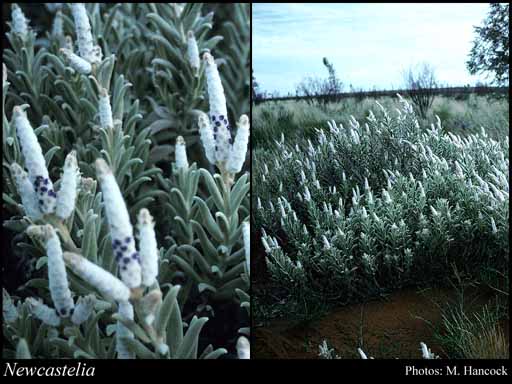- Reference
- Hooker's J.Bot.Kew Gard.Misc. 9:22 (1857)
- Name Status
- Current

Scientific Description
Common name. Lambstail. Family Lamiaceae.
Sometimes included in Chloanthaceae, Verbenaceae.
Habit and leaf form. Small perennial shrubs; evergreen; without essential oils; not resinous. ‘Normal’ plants to switch-plants (somewhat switch-plant-like, owing to sparse leaves and broom-like habit). Leaves well developed, or much reduced. Plants unarmed. Leaves cauline. Young stems cylindrical. Stem internodes solid (woody; decussately branched). To 0.3–4 m high. Leptocaul. Leaves small to medium-sized; not fasciculate; opposite, or whorled; decussate; 3 per whorl; not decurrent on the stems; ‘herbaceous’; not imbricate; sessile; aromatic, or without marked odour; simple; epulvinate. Leaf blades entire; rolled (recurved along margins); linear, or lanceolate, or oblong, or ovate; narrow linear, or ovate (sometimes broadly), or oblong, or elliptic; pinnately veined; cross-venulate. Mature leaf blades adaxially woolly (but sometimes glutinous-glandular (glabrous),somewhat scaberulous or sparsely tomentose); abaxially woolly. Leaves without stipules. Leaf blade margins entire; revolute. Leaves without a persistent basal meristem. Leaf anatomy. Hairs present; glandular hairs present (sometimes); complex hairs present. Complex hairs stellate. Stem anatomy. Secondary thickening anomalous; via concentric cambia.
Reproductive type, pollination. Fertile flowers hermaphrodite. Unisexual flowers absent. Plants hermaphrodite. Plants homostylous. Entomophilous.
Inflorescence and flower features. Flowers solitary, or aggregated in ‘inflorescences’; terminal. Inflorescence many-flowered. Flowers not in pairs subtended by a common bract; in spikes. Inflorescences terminal; dense elongated spikes or more or less subglobose heads, terminal on branches, woolly tomentose. The fruiting inflorescence not conelike. Flowers sessile to subsessile; bracteate (bracts opposite, decussate). Bracts deciduous. Flowers bracteolate; small; regular; 5–6 merous (rarely more); cyclic; tetracyclic. Free hypanthium absent. Hypogynous disk absent. Perianth with distinct calyx and corolla; 10; 2 -whorled; isomerous. Perianth members entire. Calyx present; 5–6(–8); 1 -whorled; gamosepalous; blunt-lobed, or toothed; exceeding the corolla; cyathiform; regular; sparse to densely covered in purplish or whitish grey, yellow or golden yellow tomentum, sometimes glandular, glabrous inside; non-fleshy; persistent; non-accrescent. Calyx lobes triangular to ovate. Corolla present; 5–6(–8); 1 -whorled; gamopetalous; blunt-lobed, or toothed; imbricate; more or less campanulate; regular; glabrous abaxially; hairy adaxially (villous-tomentose); plain; purple to violet, or blue, or yellow, or white to yellow. Corolla lobes triangular to ovate, or ovate, or linear (to narrow), or elliptic to orbicular. Corolla members entire. Androecium present. Androecial members definite in number. Androecium 5–6 (rarely more). Androecial members adnate (epipetalous); all equal; free of one another; 1 -whorled. Androecium exclusively of fertile stamens. Stamens 5–6(–8). Staminal insertion in the throat of the corolla tube. Stamens becoming exserted, or remaining included; all more or less similar in shape; isomerous with the perianth; oppositisepalous. Filaments glabrous; filiform. Anthers dorsifixed; dehiscing via longitudinal slits; bilocular (lobes more or less oblong, free and divergent in the lower halves). Gynoecium 2 carpelled. The pistil 4 celled. Carpels reduced in number relative to the perianth. Gynoecium syncarpous; synstylovarious (styles free in upper part); superior. Ovary plurilocular; 2 locular (morphologically), or 4 locular (ostensibly, via false septa). Locules secondarily divided by ‘false septa’. Gynoecium median. Ovary summit glabrous (glandular at the top), or hairy, the hairs not confined to radiating bands (sometimes). Gynoecium stylate. Styles 1; simple (filiform); apical; much longer than the ovary at anthesis; becoming exserted, or not becoming exserted; hairless (glabrous). Stigmas 1; 1 - lobed (sometimes minutely notched). Placentation axile. Ovules 2 per locule (theoretically), or 1 per locule (ostensibly, i.e.per locellus); semi apotropous (attached at or about the middle of central axis); non-arillate; hemianatropous.
Fruit and seed features. Fruit non-fleshy; indehiscent; a nut; 4 celled; 4 locular. Dispersal unit the seed. Fruit 1–2 seeded. Seeds endospermic. Embryo straight.
Special features. Perianth (calyx) woolly outside. Inflorescence determinate. Calyx limb 5–6(–8) lobed. Corolla tube exceeding the calyx, or not exceeding the calyx; straight.
Geography, cytology, number of species. Native of Australia. Endemic to Australia. Australian states and territories: Western Australia, South Australia, Northern Territory, and Queensland. Eremaean Botanical Province. A genus of 12 species (1 excluded); 10 species in Western Australia; 5 endemic to Western Australia.
Etymology. After Henry Pelham Clinton, 5th Duke of Newcastle (1811–64), secretary of state for the colonies 1852–54; provided funds for A. C. Gregory's expedition to northern Australia 1855, on which Mueller was the botanist (often spelt Newcastlia).